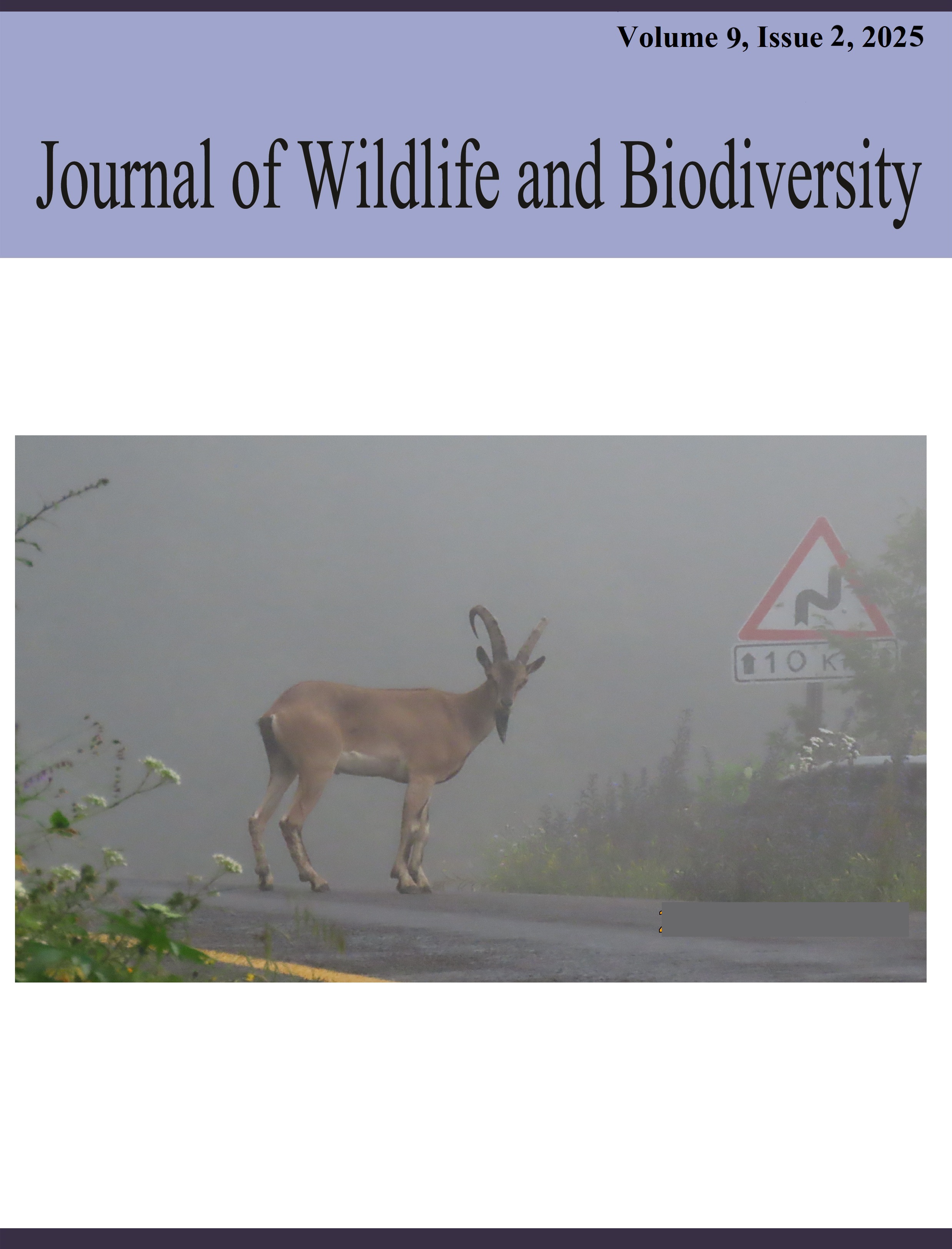Contamination of some Vegetables with parasites in Amedi District – Kurdistan Region
DOI:
https://doi.org/10.5281/zenodo.15521651Keywords:
vegetables, ova, oocyst, cyst, AmediAbstract
The current study investigated the presence of parasitic infective stages, such as ova, oocysts, and cysts, in infected raw vegetables in Amedi District. Out of 700 fresh vegetable samples were obtained from various locations, including home gardens, vegetable fields, and local markets. Various types of vegetables were examined, such as Lettuces (127), Cabbage (106), Celery (130), Parsley (165), Carrot (64), and Radish (108). Helminth ova, cysts, and oocysts of different parasites were found in 593 (84.71%) samples. E. granulosus ova were found in 117 (16.71%), followed by E. histolytica cysts in 107 (15.28%), Giardia cysts in 106 (15.14%), Toxoplasma gondii oocysts in 95 (13.57%), Ascaris ova in 71 (10.14%), Hymenolepis nana in 51 (7.28%), and Toxocarra ova in 46 (6.57%). The contamination rates of T. gondii, Hymenolepis nana ova, Toxocarra ova, and E. histolytica cysts were significantly higher (P < 0.05) compared to other helminths and protozoans such as E. granulosus ova, Giardia cyst, and Ascaris ova. In conclusion, eating raw and unwashed vegetables may be contaminated with ova, oocysts, or cysts of parasites, and contamination might be greatly underestimated, particularly in areas with inadequate sanitation. Vegetables can become contaminated with parasites in a variety of ways, such as during production, processing, storage, and sales. Therefore, contamination may be eliminated by implementing sanitary measures at every stage of production and consumption.
References
Abdullah, A. M. (2021). Contamination of fresh vegetables with protozoan parasites in Duhok City, Kurdistan Region of Iraq. Medical Journal of Babylon, 18, 416–420.
Al-Niaeemi, B. H., Ahmed, N. M., & Kharofa, W. A. (2022). Parasitic contamination of some fresh and collected vegetables from Mosul City markets. Revis Bionatura, 7(3), 26. https://doi.org/10.21931/RB/2022.07.03.26
Bouzid, M., Kintz, E., & Hunter, P. R. (2018). Risk factors for Cryptosporidium infection in low and middle-income countries: A systematic review and meta-analysis. PLoS Neglected Tropical Diseases, 12, e0006553. [PMC free article] [PubMed] [Google Scholar]
Dawson, D. (2005). Foodborne protozoan parasites. International Journal of Food Microbiology, 103, 207–227. [PubMed] [Google Scholar]
Duedu, K. O., Yarnie, E. A., Tetteh-Quarcoo, P. B., Attah, S. K., Donkor, E. S., & Ayeh-Kumi, P. F. (2014). A comparative survey of the prevalence of human parasites found in fresh vegetables sold in supermarkets and open-aired markets in Accra, Ghana. BMC Research Notes, 7, 836. [PMC free article] [PubMed] [Google Scholar]
Faraj, A. M. (2000). Prevalence of intestinal parasites in some kindergartens in the center of Erbil, Northern Iraq. Journal of Dohuk University, 3(1), 7–12.
Fathailah, Z. I. (1988). The presence of human parasites in vegetables collected from different markets in Baghdad city (Master’s thesis, University of Baghdad).
Fletcher, S. M., Stark, D., Harkness, J., & Ellis, J. (2012). Enteric protozoa in the developed world: A public health perspective. Clinical Microbiology Reviews, 25, 420–449. [PMC free article] [PubMed] [Google Scholar]
Giangaspero, A., & Gasser, R. B. (2019). Human cyclosporiasis. The Lancet Infectious Diseases, 19, e226–e236. [PubMed] [Google Scholar]
Guirges, Y., & Al-Mofti, A. (2005). The presence of protozoal cysts and helminthic ova on vegetables collected from Baghdad markets. Journal of the Faculty of Medicine, University of Baghdad, 47(1), 70–72.
Herman, K. M., Hall, A. J., & Gould, L. H. (2015). Outbreaks attributed to fresh leafy vegetables, United States, 1973–2012. Epidemiology and Infection, 143, 3011–3021. [PMC free article] [PubMed] [Google Scholar]
Julian, T. R. (2016). Environmental transmission of diarrheal pathogens in low and middle-income countries. Environmental Science: Processes & Impacts, 18, 944–955. [PubMed] [Google Scholar]
Mahmood, M. H., Rahimo, Z. I. F., & Abdul-Faraj, M. S. (2011). Intestinal parasitic pollution of vegetables and fruits in Mosul. In The Second Scientific Conference of Environment and Pollution Control Research Center, University of Mosul, Iraq (pp. 159–173).
Mirzaei, Y., Mohammadi, C., Ahmad, S. F., Hamad, P. M., & Samiei, A. (2021). Prevalence of intestinal parasites in raw vegetables consumed in Soran City, Kurdistan Region-Iraq. Annals of Parasitology, 67(2), 275–279.
Olza, J., Aranceta-Bartrina, J., González-Gross, M., Ortega, R.M., Serra-Majem, L., Varela-Moreiras, G., et al. (2017). Reported dietary intake and food sources of zinc, selenium, and vitamins A, E, and C in the Spanish population: Findings from the ANIBES study. Nutrients, 9, 697. [PMC free article] [PubMed] [Google Scholar]
Ryan, U., Hijjawi, N., & Xiao, L. (2018). Foodborne cryptosporidiosis. International Journal of Parasitology, 48, 1–12. [PubMed] [Google Scholar]
Ryan, U., Paparini, A., & Oskam, C. (2017). New technologies for detection of enteric parasites. Trends in Parasitology, 33, 532–546. [PubMed] [Google Scholar]
Saida, L. A., & Nouraddin, A. S. (2011). Epidemiological study of cystic echinococcosis in man and slaughtered animals in Erbil province, Kurdistan Region-Iraq. Tikrit Journal of Pure Science, 16(4), 45–50.
Soulsby, E. J. L. (1982). Helminths, arthropods and protozoa of domesticated animals (7th ed.). Bailliere Tindall.
Utaaker, K. S., Kumar, A., Joshi, H., Chaudhary, S., & Robertson, L. J. (2017). Checking the detail in retail: Occurrence of Cryptosporidium and Giardia on vegetables sold across different counters in Chandigarh, India. International Journal of Food Microbiology, 263, 1–8. [PubMed] [Google Scholar].
Downloads
Published
How to Cite
Issue
Section
License
Copyright (c) 2025 Journal of Wildlife and Biodiversity

This work is licensed under a Creative Commons Attribution 4.0 International License.


